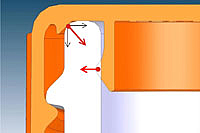Plastic caps for products hot-filled in PET bottles are at the moment almost all made from temperature-resistant polypropylene and are fitted with a separate liner.
Corvaglia began the development of a one-piece cap in HDPE four years ago. As well as addressing the tendency to deform when subjected to elevated temperatures, there was first the matter of ensuring a leak-proof seal at ambient temperatures. Immediately after filling there is a slight overpressure in the bottle and as the temperature falls a slight vacuum is created. However PET and PE shrink at quite different rates and so the combination of these two factors can lead to so-called micro leakage, especially at the critical phase between the over-pressure and the partial vacuum. This also opens up the possibility of the contents becoming contaminated by bacteria.Using a newly-developed geometry the two-start 38mm cap, when it has been screwed onto the bottle, has sufficient pre-tension to form a perfect seal (fig.1), which is actually reinforced by the distortion of the cap under vacuum (fig. 2).
 Fig. 1: Pre-tension formed after fitting the cap |  Fig. 2: Concave deformation reinforces the sealing action |
This solution for a one-piece HDPE cap allows considerable cost savings in comparison with the previous PP cap and separate liner.
Using the one-piece Corvaglia hot-fill cap it is possible to achieve cost savings of over 30 percent, said Romeo Corvaglia, managing director of Corvaglia Holding AG.
It was a rocky road to break the ingrained habit of using a liner. The main task was to convince the fillers. We haven't done any extra development work on the cap since it was launched 4 years ago, said Bernardo Osés, general manager of Corvaglia Closures S.A. de C.V. in Ixtlahuaca, Mexico.

| Natalia Garcia ph: +41 71 973 77 03 n.garcia@corvaglia.ch |





